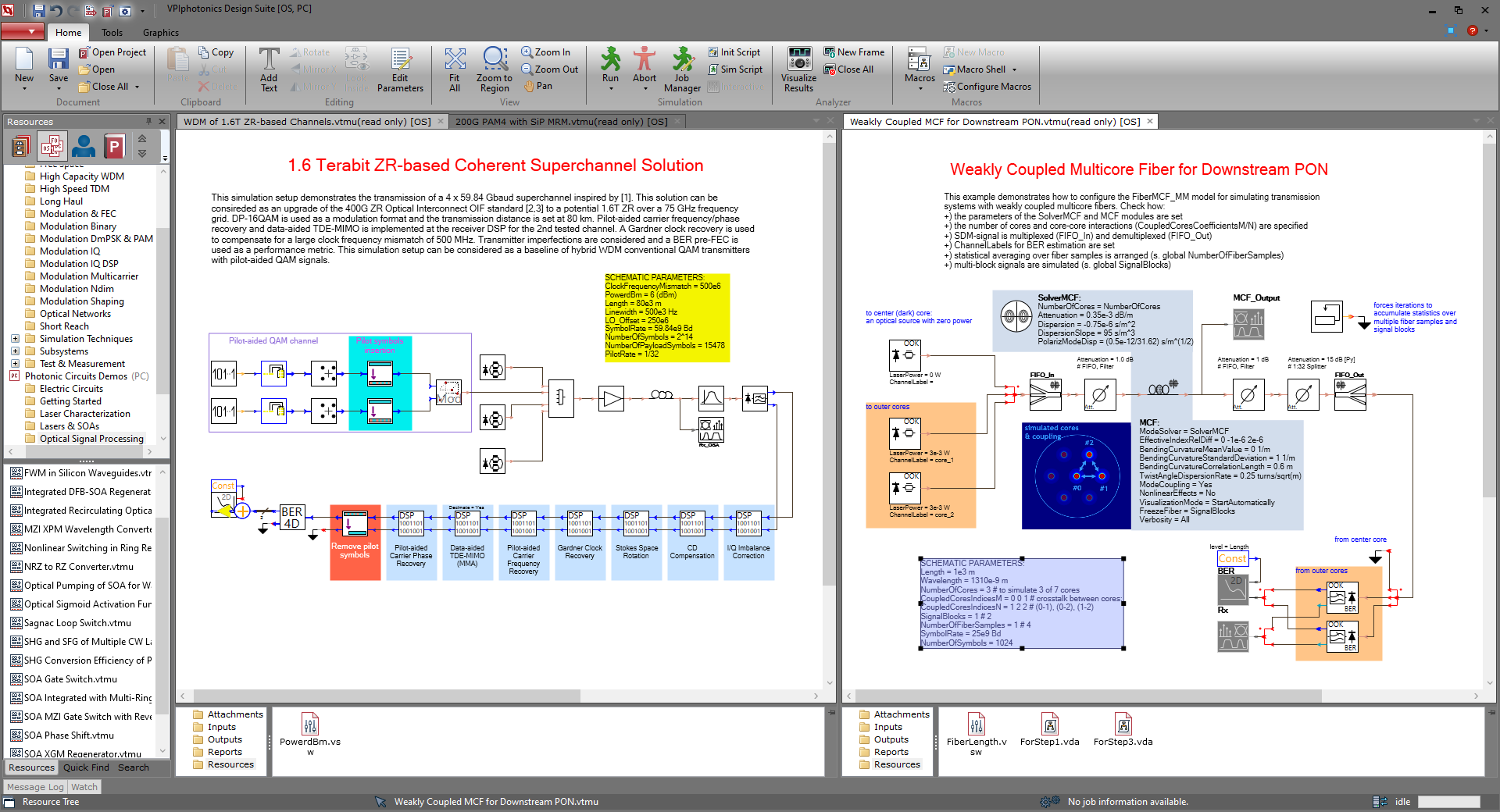VPIphotonics Design Suite Version 11.5 provides access to professional application-specific simulation tools and add-on toolkits for photonic components and optical transmission systems. They offer flexible usability, design process, and analysis capabilities.
Version 11.5 advances the simulation and design flow for many applications, including direct detection and
coherent transmission systems, free-space optics-based satellite communications, spatial division multiplexing,
passive photonic devices, semiconductor optical lasers and amplifiers, and many more.
Our software solutions have utilized numerous commercial companies and educational institutions to win and
successfully execute many research and design projects. With the improved capabilities provided in Version 11.5,
our design suite is set to deliver the same outstanding results in the future.

Photonic Design Environment (PDE) of Version 11.5
New macro for the automated creation of coherent M-QAM-based WDM or single-channel transmission systems, including format-dependent DSP chain
Demo of a 1.6Tb ZR-based coherent superchannel transmission over 80 km using four DP-16QAM channels and a pilot-aided DSP chain
Demo of a multi-parallel optical DAC architecture for 64-QAM coherent systems
DFE/FFE with a new debiasing option, two output formats to accommodate different use cases, and optional usage of pre-set filter taps uploaded from a file
Performance estimation in direct-detection systems: range limit of output BER values, output of fitted PDF parameters, and calculation of LLR and GMI for PAM-M signals
New model of weakly coupled homogeneous and heterogeneous single-mode multicore fibers, including intracore linear and nonlinear propagation effects, as well as intercore crosstalk and skew attributed to fiber bending, twist, and longitudinal parameter variations
Demo on the intercore crosstalk in weakly coupled heterogeneous and homogeneous MCFs, analyzing the dependence on bend radius and propagation constant mismatch
Demo of an SDM-based downstream PON using weakly coupled MCF illustrating the parameter configuration of the new MCF model
Demo of a random distributed feedback fiber laser with a mirrorless open cavity that operates based on Rayleigh scattering and stimulated Raman scattering
Faster FSO atmospheric and inter-satellite channel models with enhanced functionality
New option for the FSO atmospheric channel model to output the calculated isoplanatic angle and Strehl ratio
Demo of performance estimation of statistically rare scintillation events in an FSO link using the importance sampling technique
Demo of the performance improvement in a GEO satellite-to-ground link with pointing and coupling losses using FEC
New passive linear photonic device model based on an S-matrix from a user-defined data file supporting data point interpolation and custom parameter dependence
Enhanced macro to create compound components based on S-Matrix files with automated detection of ports and parameter dependencies
Demo of a silicon photonics MMI coupler based on an S-matrix file that has been pre-created with VPIdeviceDesigner
Enhanced macro to visualize the structure of multi-sectional semiconductor devices, including view and editing of specific parameters of individual device sections and facets
Enhanced characterization modules for semiconductor optical amplifiers and lasers, offering improved efficiency and broader parameter control options
Improved PPLN model with optional automatic calculation of the poling period and extended documentation
New balanced photodetection model with control of responsivity imbalance and CMRR
Demo of an MRM-based 50Gb PAM-4 system interfacing photonic circuit simulation with optical link performance simulation
Symbolic physical constants (c, h, k, e, etc.) and instant access to scipy.constants available now within parameter expressions
New macro to convert various physical quantities and units (wavelength, bandwidth, power, attenuation coefficient, dispersion parameters, Kerr nonlinearity parameters)
New module for displaying numerical values in the Message Log panel and tracking the progress of iterative processes
New JupyterLab interface based on Python cosimulation for seamless integration of Jupyter notebooks with VPI Design Suite
Upgraded read-in capabilities for previously saved signal files into a simulation, including signals with mismatched time window
Enhanced Parameter Editor with an auto-complete pop-up menu and the possibility to store and retrieve parameters in a csv, or xlsx file
Enhanced module port context menu on the schematic for easy access to wiring, signal source, data file interfacing, cosimulation, and favorites modules
New option in the Watch panel to trace the dependency of parameters on other parameters
New access to galaxy init-script from a galaxy instance parameter expression to provide a set of utility functions together with a module
Access to initialization and simulation scripts via new buttons in the PDE ribbon
Enhanced node selection in the Object Browser to simplify finding multiple objects in a complex schematic and performing operations via the context menu
Creating a new project or mark an existing folder as a project directly in Windows File Explorer
Enhanced Search to look for modules that have a parameter with some specific name
New support of diagrams.net for drawing flowcharts, process and network diagrams, LaTeX-based formulas, and much more directly on the schematic for decoration
Improved visualization and operations with predecessor modules
Enhanced Analyzer control option to control highlighting the selected symbol in the constellation diagram
Enhanced Analyzer control option to exclude specific symbols from both metric calculations and the eye diagram display
Support for LaTeX formulas in annotations, allowing the use of Greek letters and mathematical equations within VPIphotonicsAnalyzer annotations
Version 11.5 provides access to more than 900 ready-to-run simulation setups. New and improved demo examples illustrate the application of the new features and modules.
The example shown here illustrates an efficient way of simulating statistically rare scintillation events in a Free Space Optical link using Importance Sampling supported by the atmospheric channel model.
This method allows for simulating user-defined values of power fluctuations due to scintillation. The total BER is calculated through a sum with weights equal to the probabilities
of these scintillation events.
Another design example simulates an FSO GEO Feeder link with FEC, illustrating the link budget analysis and exploring the pre- and post-FEC system performance.